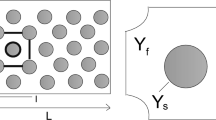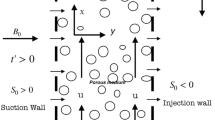Abstract
The energy transfer and dissipation as well as the turbulent structures in a lid-driven cavity flow with porous walls are investigated via the lattice Boltzmann method, with direct numerical simulation (DNS) for an isothermal incompressible flow for which the Reynolds number (Re) is 50 000. A generalized Navier-Stokes equation with the Brinkman-Forchheimer-extended Darcy model is implemented, in which the presence of permeable walls is taken into account. This study focuses on the modulations of the flow field due to porous walls, by comparing with the results from the cavity flow bounded with smooth walls. Firstly, we derived the exact expression of the kinetic energy dissipation rate in a cavity to study the budget balance of the induced and dissipated kinetic energy. By decomposing the total kinetic energy dissipation into the componential contributions of the viscous and porous medium layer, we found that the kinetic energy dissipated in the thin porous layer occupies 37% of the total driven lid-induced kinetic energy in the present parameters. Then we found that the time-averaged kinetic energy, turbulent kinetic energy (TKE), as well as the strength of the large-scale energy-containing eddy, and secondary eddies are significantly attenuated. Furthermore, it is found that the momentum and kinetic energy transfer near the corners are vastly decreased. Finally, the space-time velocity correlation functions are also provided to examine the decorrelation property of small eddies by means of convection and distortion motions in the cavity turbulent field.
Similar content being viewed by others
References
Prasad A. K., Koseff J. R. Reynolds number and end-wall effects on a lid-driven cavity flow [J]. Physics of Fluids A Fluid Dynamics, 1989, 1(2): 208–218.
Samantaray D., Das M. K. High Reynolds number incompressible turbulent flow inside a lid-driven cavity with multiple aspect ratios [J]. Physics of Fluids, 2018, 30(7): 075107.
Leriche, E., Gavrilakis S. Direct numerical simulation of the flow in a lid-driven cubical cavity [J]. Physics of Fluids, 2000, 12(6): 1363–1376.
Koseff J. R., Street R. L. On end wall effects in a lid-driven cavity flow [J]. Journal of Fluids Engineering, 1984, 106(4): 385–389.
Ghia U., Ghia K. N., Shin C. T. High-Re solutions for incompressible flow using the Navier-Stokes equations and a multigrid method [J]. Journal of Computational Physics, 1982, 48(3): 387–411.
Du R., Shi B. C. Incompressible multi-relaxation-time lattice Boltzmann model in 3-D space [J]. Journal of Hydrodynamics, 2010, 22(6): 758–787.
Santhosh K. D., Dass A. K., Anupam D. A multigrid-accelerated three-dimensional transient-flow code and its application to a new test problem [J]. Journal of Hydrodynamics, 2010, 22(6): 838–846.
Garcia S. Aperiodic, chaotic lid-driven square cavity flows [J]. Mathematics and Computers in Simulation, 2011, 81(9): 1741–1769.
Lestandi L., Bhaumik S., Avatar G. R. K. C. et al. Multiple hopf bifurcations and flow dynamics inside a 2D singular lid driven cavity [J]. Computers and Fluids, 2018, 166: 86–103.
Garcia S. Chaos in the lid-driven square cavity [J]. Mathematics and Computers in Simulation, 2017, 142: 98–112.
Debabrat S., Kumar D. M. High Reynolds number incompressible turbulent flow inside a lid-driven cavity with multiple aspect ratios [J]. Physics of Fluids, 2018, 30(7): 075107.
Li Q., Pan M., Zhou Q. et al. Turbulent drag modification in open channel flow over an anisotropic porous wall [J]. Physics of Fluids, 2020, 32(1): 015117.
Lin Q., Meng Q. R., Lu D. Q. Waves propagating over a two-layer porous barrier on a seabed [J]. Journal of Hydrodynamics, 2017, 30(3): 453–462.
Pokrajac D., Manes C. Velocity measurements of a free surface turbulent flow penetrating a porous medium composed of uniform-size spheres [J]. Transport in Porous Medium, 2009, 78(3): 367–383.
He X., Apte S., Finn J. et al. Characteristics of turbulence in a face-centred cubic porous unit cell [J]. Journal of Fluid Mechanics, 2019, 873: 608–645.
Nithiarasu P., Seetharamu K. N., Sundararajan T. Finite element modelling of flow, heat and mass transfer in fluid saturated porous medium [J]. Archives of Computational Methods in Engineering, 2002, 9(1): 3–42.
Rosti M. E., Brandt L., Pinelli A. Turbulent channel flow over an anisotropic porous wall-drag increase and reduction [J]. Journal of Fluid Mechanics, 2018, 842: 381–394.
Habib R., Karimi N., Yadollahi B. et al. A pore-scale assessment of the dynamic response of forced convection in porous media to inlet flow modulations [J]. International Journal of Heat and Mass Transfer, 2020, 153: 119657.
Wang L., Mi J., Guo Z. A modified lattice Bhatnagar-Gross-Krook model for convection heat transfer in porous medium [J]. International Journal of Heat and Mass Transfer, 2016, 94: 269–291.
Al-Amiri A. M. Analysis of momentum and energy transfer in a lid-driven cavity filled with a porous medium [J]. International Journal of Heat and Mass Transfer, 2000, 43(19): 3513–3527.
Najib H., Brahim B. B. Numerical study of laminar mixed convection flow in a lid-driven square cavity filled with porous medium: Darcy-Brinkman-Forchheimer and Darcy-Brinkman models [J]. International Journal of Numerical Methods for Heat and Fluid Flow, 2018, 28(4): 857–877.
Tian H., Li Q., Pan M. et al. High-Schmidt-number dissolved oxygen transfer from turbulent flows to permeable microbial sediment bed [J]. Advances in Water Resources, 2019, 125: 1–12.
Wang B. F., Zhou Q., Sun C. Vibration-induced boundary-layer destabilization achieves massive heat-transport enhancement [J]. Science Advances, 2020, 6(21): eaaz8239.
Zhou Q., Xia K. Q. Thermal boundary layer structure in turbulent Rayleigh-Bénard convection in a rectangular cell [J]. Journal of Fluid Mechanics, 2013, 721: 199–224.
He G., Jin G., Yang Y. Space-time correlations and dynamic coupling in turbulent flows [J]. Annual Review of Fluid Mechanics, 2017, 49(1): 51–70.
Dong Y., Sagaut P. A study of time correlations in lattice Boltzmann-based large-eddy simulation of isotropic turbulence [J]. Physics of Fluids, 2008, 20(3): 035105.
Author information
Authors and Affiliations
Corresponding author
Additional information
Projects supported by the Natural Science Foundation of China (Grant Nos. 91852111, 92052201, 12172207 and 11972220), the Program of the Shanghai Municipal Education Commission (Grant No. 2019-01-07-00-09-E00018).
Biography: Wen-wu Yang (1990-), Male, Ph. D. Candidate
Rights and permissions
About this article
Cite this article
Yang, Ww., Wang, Bf., Zhou, Q. et al. The driven cavity turbulent flow with porous walls: Energy transfer, dissipation, and time-space correlations. J Hydrodyn 33, 712–724 (2021). https://doi.org/10.1007/s42241-021-0072-2
Received:
Revised:
Accepted:
Published:
Issue Date:
DOI: https://doi.org/10.1007/s42241-021-0072-2




